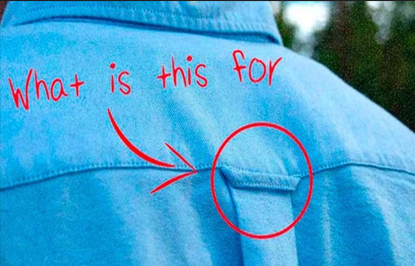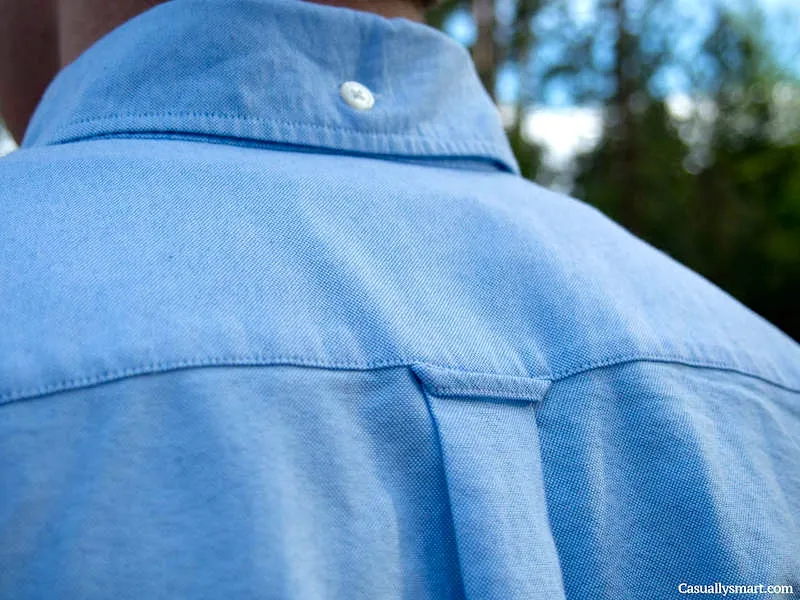The button-down shirt has been a go-to staple for decades, a versatile wardrobe choice that balances casual charm and classic sophistication. But have you ever noticed that small loop on the back of some button-down shirts? It might look like an insignificant detail, but that “locker loop” carries a fascinating backstory, bridging the worlds of practicality, collegiate style, and even social signaling.
Let’s delve into the intriguing history of the locker loop and see how it became a quiet icon in the world of menswear, starting with its humble origins in the Navy, to its stylish adoption by Ivy League students, and how it eventually became a mark of taste and personalization in men’s fashion.
The Naval Origins of the Locker Loop: A Practical Innovation

Imagine life on a Navy ship—tight quarters, limited space, and a pressing need to stay organized. Sailors, dealing with the lack of traditional storage options, often had nowhere to hang their shirts when off-duty. To solve this problem, shirtmakers added small loops on the back of their uniforms.
These loops, which came to be known as “locker loops,” allowed sailors to easily hang their shirts on hooks, minimizing wrinkles and saving space. It was purely practical, a quick-fix solution to the challenges of naval life, and it had nothing to do with style. However, this unassuming detail would soon make its way into the civilian world, becoming a celebrated part of button-down culture.
The Ivy League Adoption: Locker Loops as a Fashion Statement
The transition from the military to mainstream fashion happened in the 1950s, largely thanks to the American clothing brand GANT. Seeking to appeal to Ivy League students who were looking for a blend of style and convenience, GANT cleverly incorporated the locker loop into their button-down shirts. For these fashion-conscious students, the loop became an easy way to keep shirts wrinkle-free in their dorm room lockers.
The loop soon gained popularity among Ivy League circles as it blended well with the preppy style and the desire for functionality. But as the trend caught on, it went beyond just practicality; it became an unspoken emblem of elite taste, worn proudly by those who valued quality and refinement. Over time, the locker loop became synonymous with Ivy League culture, taking on a life of its own.
Symbolism and Social Significance: The Loop as a Relationship Status Indicator
In the Ivy League, the locker loop didn’t just represent functionality or style—it also came to signify relationship status. Male students would often remove the loop from their shirt to signal that they were no longer single. This subtle gesture was a way for them to show they were “taken,” much like a modern-day relationship status update.
The tradition didn’t stop there; female students would sometimes wear their boyfriend’s scarf as a reciprocal sign of commitment. And in true college fashion, the locker loop soon became a target for pranks. Some mischievous students would tug at the loops on their peers’ shirts as a playful way to show affection or tease someone they fancied, although this often resulted in an unsightly hole in the shirt!
This playful use of the locker loop added a layer of social interaction to its significance, making it more than just a functional accessory.
Locker Loops in Popular Culture: A Mark of Quality and Taste
As the Ivy League look gained popularity outside the college setting, the locker loop became a recognized feature in menswear fashion. Top brands like Sero, Wren, Creighton, and Eagle joined GANT in adding loops to their button-down shirts, turning the loop into a mark of high quality and style. It wasn’t just for preppy college kids anymore; the locker loop had evolved into a symbol of classic menswear, appealing to a broader audience who valued tradition and craftsmanship.
Over the years, even as hanger designs improved and the need for locker loops declined, brands kept including the loop as a nod to history. It became a subtle statement of style, a wink to those in the know about the origins and significance of this small yet impactful feature.
Modern Menswear: Locker Loops as Personalization and Style Choice

Today, the locker loop remains a choice for style enthusiasts who appreciate both fashion history and customization. While the practical need for the loop may have diminished, it offers a personalized touch. Some men even request tailors to add or remove loops from their shirts as a unique way to pay homage to classic menswear traditions.
Whether it’s a nod to the Ivy League, a token of old-world naval functionality, or simply a stylistic choice, the locker loop is a feature that connects wearers to a storied history. Its presence on a shirt is a mark of individuality, allowing wearers to express their taste and preference subtly yet meaningfully.
The Lasting Legacy of the Locker Loop: A Nod to Fashion’s Evolution
The locker loop may seem like an insignificant detail, but it holds a lasting place in menswear. From naval innovation to Ivy League campuses, and ultimately to mainstream fashion, this small loop represents a journey of transformation. It serves as a reminder of how style can evolve from the purely practical to the deeply symbolic, bridging functional needs with fashion sensibilities.
When you next slip on a button-down shirt, take a moment to notice whether it has a locker loop. In that small detail lies a rich history of naval efficiency, collegiate style, and a dash of social playfulness. The locker loop is more than a piece of fabric; it’s a piece of fashion history that has gracefully woven itself into the very fabric of menswear.
Now you know the story behind that tiny loop on your button-down shirt. What started as a simple solution for sailors has become a marker of style, taste, and even romance. It’s a reminder that fashion often carries hidden histories, waiting for us to discover them, one loop at a time. So next time you wear your favorite shirt, take a moment to appreciate its legacy—and maybe even share the story with someone else.


